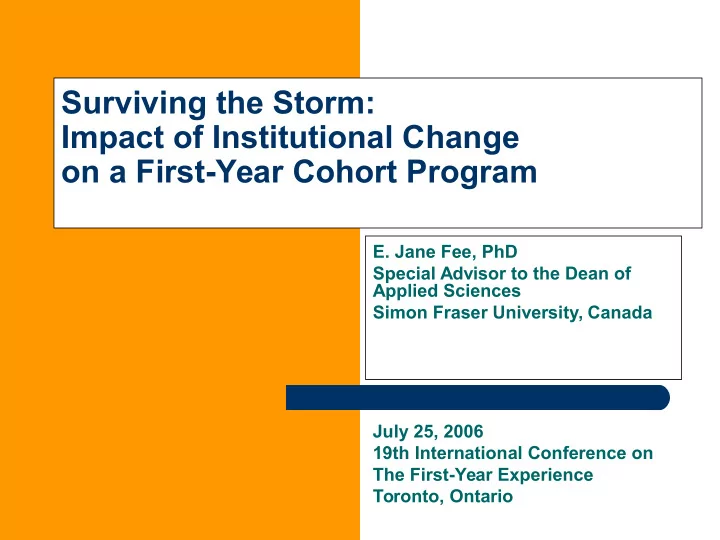

Surviving the Storm: Impact of Institutional Change on a First-Year Cohort Program E. Jane Fee, PhD Special Advisor to the Dean of Applied Sciences Simon Fraser University, Canada July 25, 2006 19th International Conference on The First-Year Experience Toronto, Ontario
Organization of Talk Program Beginnings at TechBC The Transition to SFU TechOne Today The Future of TechOne Lessons Learned
The Technical University of BC (TechBC) Public, niche university Legislation passed – December 1997 Specialized mandate to deliver high-tech programs: Interactive Arts, Information Technology, Management & Technology –“Doubling the Opportunity” initiative Located on south side of Fraser River - highest growth area in B.C. - lowest participation rates in post-secondary
Academic Innovations at TechBC Student success model Blended learning pedagogy No Faculty structures – faculty appointed to University Commitment to interdisciplinary models – all courses/programs developed by faculty teams Small class sizes
Immediate Challenges CAUT Boycott – Fall 1997 Provincial degree program approval process Permanent facility would be built “off book” by Crown Corporation Temporarily located in leased space Capital funding model at 50% of COU standards
TechOne Program Structure Integration of content across courses – learning community model Courses a mix of online and F2F delivery Education, Technology and Learning Unit Support program 36 credits of required coursework
The TechOne Courses Disciplinary courses in IA, IT, Business Interdisciplinary courses in Math/Physics/Stats Process elements: communication, teamwork, information literacy Integration of content through process element courses Cohort – lab classes of 24 All courses taught in 1-credit, 5 week modules
The Beginning of the End New President hired summer 2001 New Liberal government elected summer 2001 Core Services Review – Fall 2001 Announcement of transfer of students and Programs to SFU – February 2002
Why was SFU interested? New campus south of the Fraser River Doubling the Opportunities initiative Innovations in online education Interactive Arts program TechOne
2002 Information Technology and Interactive Arts Programs frozen – Became “The Surrey Programs” in Faculty of Applied Sciences Management & Technology dissolved – Students transferred to Faculty of Business Administration 200 students accepted to TechOne Campus staffing arrangements change TechOne acknowledged as independent program
Transition to a Disciplinary Structure –2002/03 TechOne courses owned and operated by home departments (IAT, CS, Bus, Math) Advisory program committee – “cooperative” model Program managed by Associate Dean Sole first-year program at SFU Surrey; serves as first year of all UG degree programs
2003 Re-Imagining Begins TechOne Restructuring – TechOne will feed ‘Doubling the Opportunities’ programs – Revised modules to regular 3-credit courses TechOne numbers double to 400 High-tech crash Special Advisor appointed
TechOne Today 10-15 limited-term lecturer positions Students largely go into IAT, Computing Science, and Business degree programs 500 students, representing – more than 50% of new BC 12 enrollment in Applied Sciences – 60% of all enrollments at SFU Surrey Competing visions beginning to coalesce
Current Curriculum Core Courses Fall Spring IAT 100 IAT 101 TECH 100 TECH 101 CMPT 120 CMPT 125 + a MATH course Electives Based on degree program
Current Management Structure Separate “Program Director” and Program Assistant Budget subsumed by IAT Program Director manages 5 core courses; consults with Computing Science re 2 courses Work co-operatively with other departments to ensure elective courses available
Why Re-design Again? Its history Vision, ownership, resourcing, consistency New general University requirements Developing vision of the SFU Surrey campus and new first-year learning community programs “One-size fits all” model isn’t working for students
SFU Surrey Vision – First Year SFU Surrey students enter the campus through first-year cohort programs designed to provide a strong foundation for their academic career and exposure to a full range of disciplinary ideas.
Why this model? Greater flexibility – in number of courses taken each semester – to take electives to fulfill major program requirements To articulate with all Applied Science undergrad programs Interdisciplinary courses become the ‘value added’ “Bullet-proofing” for possible changes in Faculty of Applied Sciences Enrollments still down in computing science
The Vision for Fall 2008 Reduced interdisciplinary core (4 courses) – Taught by interdisciplinary TechOne faculty Certificate in Collaborative Technologies to be awarded at end of year One program within a new “Department of X” Back to learning communities model
The Framework An integrated set of 4 courses Spring Fall Analytical History & Design: Communicati & Social Theory on Critical Implications & & Reasoning of Practice Collaboration Technology (W) Theme electives as required Information Technology Theme Digital Media Theme
Short-term Challenges New University-wide curriculum changes Increased competition for new students – BC wide – Within our campus Resources – Faculty are 90% LT teaching faculty – Very lean on staffing Possible restructuring of Faculty of Applied Sciences
Lessons Learned First year students require lots of support: An effective first-year program must have full-time continuing faculty resources You must work closely with student support units to create seamless services (e.g., Student Life, Writing Support, Orientation) Young, enthusiastic faculty will naturally gravitate to innovative first-year programs. You must find ways to attract more senior, experienced faculty
Lessons Learned Structures/Funding Programs must own and control their own resources Innovative programs require innovative structures Government policy is always 5 years behind reality Assessment is a powerful ally
Lessons Learned Inertia You must be ever vigilant in the creation of innovative programs; any challenge will result in going back to “the way we’ve always done it” The efficacy of well-established programs is not questioned; you must provide evidence of success for new and innovative programs There will always be those who are not supportive of anything new or different. Just accept this and move on
Reasons for Optimism New Surrey campus opens September 8, 2006 Developing partnerships, and technology initiatives are on the horizon General readiness for reform at SFU Data shows we are being successful (retention = 85%) Students and faculty love the program
www.surrey.sfu.ca
www.sfu.ca/techone
Recommend
More recommend